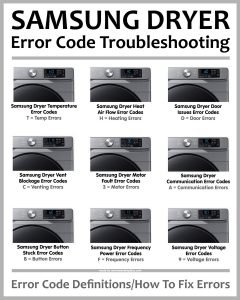
Picture this: you’re about to tackle a mountain of laundry when your dryer throws up an error code. It feels like the equivalent of your car’s check engine light illuminating just when you have somewhere important to be. Frustrating, right? This little code, E1, is your dryer’s way of saying, “Hey, something’s not quite right here!” But don’t worry, it doesn’t necessarily mean you need to throw out the dryer or call an expert right away. Understanding what E1 represents and knowing how to respond can save you time, worry, and potentially a service call.
Understanding Error Code E1: What Does It Mean?
Error Code E1 on a Samsung dryer generally indicates a problem with the dryer’s thermistor. Now, you might ask, what is a thermistor? Well, it’s a small sensor that measures temperature. Think of it like a thermostat in your home, but for your dryer. It helps the dryer regulate temperature to ensure your clothes are drying efficiently without overheating or staying damp.
When the E1 code pops up, it usually suggests that the thermistor is either malfunctioning or getting incorrect readings. This could be due to dirt and lint buildup or a more complicated wiring issue. Imagine trying to read a thermometer that’s covered in steam – it wouldn’t give you an accurate reading, would it? Similarly, if the thermistor is obstructed or faulty, it sends the wrong signals to the dryer, causing it to display this error code.
In most cases, the E1 code is an early warning system. It tells you something needs to be checked out, but your dryer isn’t about to explode or anything. However, ignoring it can lead to inefficiencies, like your dryer taking longer to finish a cycle or, in rare cases, overheating, which could pose safety concerns.
Is It Safe to Continue Using the Dryer with Error Code E1?
Here’s the deal: While you might still be able to use your dryer with the E1 code showing, it’s not without its risks. Continued use could lead to increased wear and tear, possibly turning a minor issue into a bigger, more expensive repair. It’s kind of like driving your car with the oil light on – you might get away with it for a while, but eventually, it’s going to cause significant problems.
The safety aspect largely depends on the nature of the problem. If the thermistor is simply dirty, the risk is lower, but if it’s faulty, the dryer might overheat. An overheating dryer can be dangerous, posing risks of fire. It’s crucial to err on the side of caution. So, if you see the E1 error, consider stopping use until you get a handle on what’s causing it.
To address this, your first step should be to clean the lint filter and exhaust vent. Often, a blocked vent can mimic issues with the thermistor. If cleaning doesn’t resolve the error, consulting the dryer’s manual or a professional is a prudent choice. Remember, safety first – if you’re ever in doubt, getting a professional to check things out is always the best path forward.
How to Fix and Prevent Error Code E1
Now, let’s discuss fixing this issue. If you’re comfortable doing some basic troubleshooting, start by unplugging the dryer. Safety is key – just like you wouldn’t work on a plugged-in appliance, always ensure it’s powered down before you start. Once you’ve done that, locate the thermistor. If you’re unsure where to find it, your dryer’s manual will be your best friend here.
After locating the thermistor, give it a good cleaning. Dust or lint buildup can interfere with its ability to read the temperature correctly. You can use a soft brush or a vacuum with a hose attachment to gently clean the area. If cleaning doesn’t solve the problem, the thermistor might need replacing. While this might sound daunting, replacing a thermistor is often a straightforward task. However, if you’re not comfortable or if the error persists, it’s wise to call in a professional.
As for prevention, regular maintenance is your ally. Make cleaning the lint filter a habit after every load. Also, ensure that the dryer’s venting system is clear and free of blockages. Conducting a thorough check-up every few months can prevent small issues from ballooning into major problems. Regular maintenance is like eating your greens – it pays off in the long run!
Final Thoughts
Error codes can be intimidating, especially when you’re not familiar with what they mean. But now that you have a better understanding of the E1 error code, you’re better equipped to address it. Remember, while the error does mean something’s not quite right, it doesn’t spell immediate disaster. With a little bit of investigation and maintenance, you can often resolve the issue on your own.
If at any point you feel out of your depth, don’t hesitate to contact a professional. Your safety and peace of mind are paramount. And moving forward, regular maintenance will be crucial in ensuring your dryer runs smoothly and efficiently. Keep that dryer happy, and it’ll keep your clothes crisp and dry, cycle after cycle.